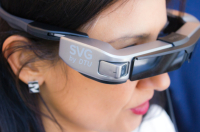Quantum race speeds up development of silicon quantum chip. U Delft scientists showed that quantum information of an electron spin can be transported to a photon, in a silicon quantum chip. This is important in order to connect quantum bits across the chip and allowing to scale up to large numbers of qubits.
Augmented reality lets doctors look under skin without scalpel. ProjectDR allows medical images such as CT scans and MRI data to be displayed directly on a patient's body in a way that moves as the patient does. The technology includes a motion-tracking system using infrared cameras and markers on the patient's body, as well as a projector to display the images. The image tracks properly on the patient's body thanks to custom software.
Biosensor monitors glucose in tears and sweat. Constantly tracking a person's glucose levels through their tears or sweat could be one step closer to providing people with diabetes an improved monitoring tool. Researchers report in the journal ACS Nano the development of an ultra-thin, flexible sensor that could be incorporated into contact lenses or on the backs of watches for real-time glucose tracking.
Nanoparticle vaccine for flu. Researchers at Georgia State University developed a nanoparticle vaccine that offers universal protection against influenza A viruses, which eliminates the need for seasonal flu vaccines. The new vaccine induces responses to the stalk part of the influenza surface glycoprotein, which is shared by all flu viruses.
Microbes to transform human waste to food? Penn State research team has shown that it is possible to rapidly break down solid and liquid waste to grow food with a series of microbial reactors, while simultaneously minimizing pathogen growth, which could be an important resource for astronauts on deep space missions.



